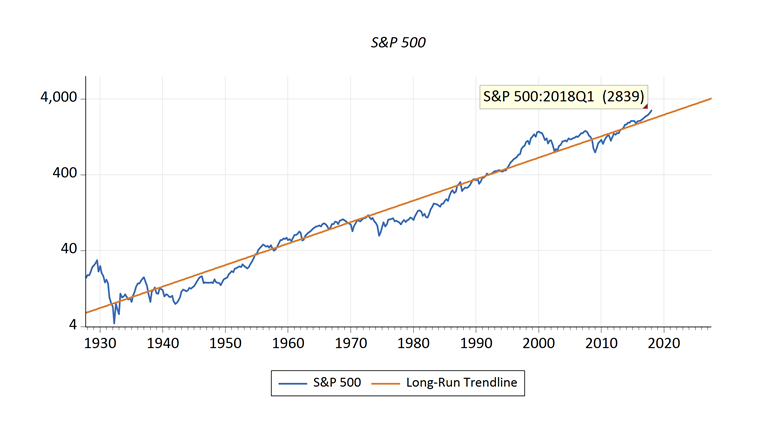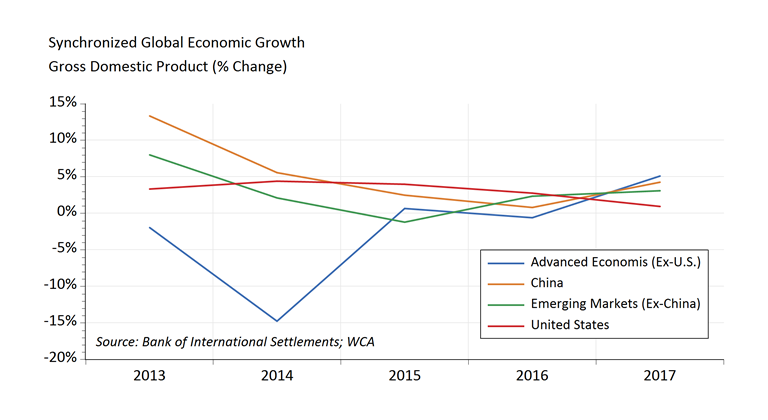Monday Morning Minute
MACROECONOMIC INSIGHT
Volatility returned to markets last week as the Dow Jones Industrial Average pared gains for the year. For the week, the index dropped roughly 4% reducing the one-year price gain to 28%.
Interestingly, the pickup in volatility was not accompanied by negative economic reports, a flattening yield curve, a widening of corporate spreads, or a cut in profit forecasts. The January employment report showed a net addition of 200,000 jobs and a 2.9% jump in hourly wage growth. Private payrolls are up a healthy 1.7% from a year ago, well above the 1% “stall rate” that has foreshadowed recession in the past. The yield spread between the Moody’s Baa corporate bond index average yield and the 10-year U.S. Treasury bond actually narrowed to 132 basis points (1.32%) versus 1.42 basis points (1.42%) a week ago. This narrowing suggests that bond investors appear to be more confident about corporate finances. The 10-year / 3-month U.S. Treasury yield spread rose to 136 basis points (1.36%) from 124 basis points (1.24%) a week ago. Lastly, analysts average S&P 500 earnings forecast for the next twelve months rose last week to $157.39 from $156.03 and is up from $132 a year ago. Simply put, last week’s pullback was not accompanied by any appreciable deterioration in “fundamentals.”
Last week’s 3.8% decline in the S&P 500 is hardly unheard of, although it hasn’t been seen recently. Since 1926, there have been more than 230 weekly declines of 3.8% or better. However, it has been over 107 weeks since we last saw a weekly drop of this size, and the S&P 500’s return has been nearly 50% since then. The long history of stock market returns shows again and again that stock values are ultimately tied to the size of the underlying economy. The chart below shows the value of the S&P 500 compared to its long-run trend over a very long period of time.
We continue to see signs of synchronized global economic growth (chart, below). The pattern of coordinated growth has been supported by a positive, but moderate, degree of credit expansion. According to data from the Bank of International Settlements, the year-over-year change in core debt to the non-financial sector rose 2.9% across advanced economies and 3.1% across emerging economies through the second quarter of 2017. This represents a pickup in credit creation in advanced economies from -2.5% growth in 2014, and a moderation in emerging markets from 13.1% growth in 2013. China’s credit growth has slowed to 4.3% growth from 22.9% in 2013. Underlying steady and coordinated economic growth supported a nearly $30 trillion rise in global stock market values to $85 trillion since the global slowdown of 2014-2015 came to an end.
ECONOMIC DATA THIS WEEK
| Date | Report | Period | Survey | Prior |
| Monday, Feb 5: | ISM Non-Manufacturing Index | Jan | 56.5 | 55.9 |
| Tuesday, Feb 6: | International Trade Balance | Dec | -$52b | -$50.5b |
| JOLTS | Dec | — | 5.879m | |
| Wednesday, Feb 7: | No Economic Data | |||
| Thursday, Feb 8: | Weekly Jobless Claims | 2/3 | 235k | 230k |
| Friday, Feb 9: | Wholesale Inventories | Dec | 0.2% | 0.2% |
| Wholesale Trade | Dec | — | 1.5% | |
| Source: Bloomberg |
ASSET ALLOCATION PORTFOLIO POSTURE
Based on shorter-term expectations, the “tactical satellite” allocation within portfolios is:
Overweight Stocks vs. Bonds
Kevin Caron, CFA, Senior Portfolio Manager
Chad Morganlander, Senior Portfolio Manager
Matthew Battipaglia, Portfolio Manager
Suzanne Ashley, Analyst
(973) 549-4052
www.washingtoncrossingadvisors.com
_______________________________________________________________________________________________________________________________________
Disclosures
WCA Fundamental Conditions Barometer Description: We regularly assess changes in fundamental conditions to help guide near-term asset allocation decisions. The analysis incorporates approximately 30 forward-looking indicators in categories ranging from Credit and Capital Markets to U.S. Economic Conditions and Foreign Conditions. From each category of data, we create three diffusion-style sub-indices that measure the trends in the underlying data. Sustained improvement that is spread across a wide variety of observations will produce index readings above 50 (potentially favoring stocks), while readings below 50 would indicate potential deterioration (potentially favoring bonds). The WCA Fundamental Conditions Index combines the three underlying categories into a single summary measure. This measure can be thought of as a “barometer” for changes in fundamental conditions.
The information contained herein has been prepared from sources believed to be reliable but is not guaranteed by us and is not a complete summary or statement of all available data, nor is it considered an offer to buy or sell any securities referred to herein. Opinions expressed are subject to change without notice and do not take into account the particular investment objectives, financial situation, or needs of individual investors. There is no guarantee that the figures or opinions forecasted in this report will be realized or achieved. Employees of Stifel, Nicolaus & Company, Incorporated or its affiliates may, at times, release written or oral commentary, technical analysis, or trading strategies that differ from the opinions expressed within. Past performance is no guarantee of future results. Indices are unmanaged, and you cannot invest directly in an index.
Asset allocation and diversification do not ensure a profit and may not protect against loss. There are special considerations associated with international investing, including the risk of currency fluctuations and political and economic events. Investing in emerging markets may involve greater risk and volatility than investing in more developed countries. Due to their narrow focus, sector-based investments typically exhibit greater volatility. Small company stocks are typically more volatile and carry additional risks, since smaller companies generally are not as well established as larger companies. Property values can fall due to environmental, economic, or other reasons, and changes in interest rates can negatively impact the performance of real estate companies. When investing in bonds, it is important to note that as interest rates rise, bond prices will fall. High-yield bonds have greater credit risk than higher-quality bonds. The risk of loss in trading commodities and futures can be substantial. You should therefore carefully consider whether such trading is suitable for you in light of your financial condition. The high degree of leverage that is often obtainable in commodity trading can work against you as well as for you. The use of leverage can lead to large losses as well as gains.
All investments involve risk, including loss of principal, and there is no guarantee that investment objectives will be met. It is important to review your investment objectives, risk tolerance and liquidity needs before choosing an investment style or manager. Equity investments are subject generally to market, market sector, market liquidity, issuer, and investment style risks, among other factors to varying degrees. Fixed Income investments are subject to market, market liquidity, issuer, investment style, interest rate, credit quality, and call risks, among other factors to varying degrees.
This commentary often expresses opinions about the direction of market, investment sector and other trends. The opinions should not be considered predictions of future results. The information contained in this report is based on sources believed to be reliable, but is not guaranteed and not necessarily complete.
The securities discussed in this material were selected due to recent changes in the strategies. This selection criteria is not based on any measurement of performance of the underlying security.
Washington Crossing Advisors LLC is a wholly owned subsidiary and affiliated SEC Registered Investment Adviser of Stifel Financial Corp (NYSE: SF).





